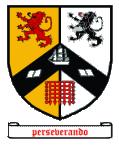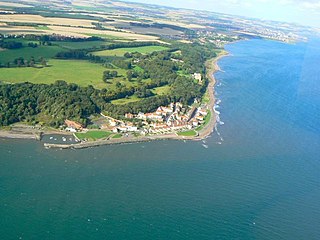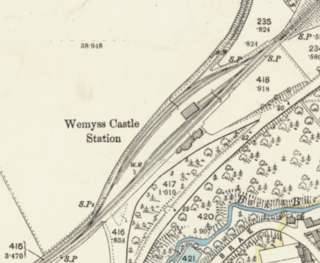Related Research Articles

Methil is an eastern coastal town in Scotland. It was first recorded as "Methkil" in 1207, and belonged to the Bishop of St Andrews. Two Bronze Age cemeteries have been discovered which date the settlement as over 8,000 years old. Famous for its High Street having the most pubs per mile in Scotland, it was part of its own barony in 1614 and also part of the former burgh of Buckhaven and Methil. This burgh existed between 1891 and 1975. It is situated within a continuous urban area described as Levenmouth.

The Alford Valley Railway is a 2 ft narrow gauge railway in the Howe of Alford, Aberdeenshire, Scotland. It is located at what used to be the terminus of the passenger and goods Alford Valley Railway which connected with the Great North of Scotland Railway main line at Kintore.

Port Glasgow railway station is on the Inverclyde Line, serving the town of Port Glasgow, Scotland. It is located in the town centre with the main entrance at the junction of Princes Street and John Wood Street.
Levenmouth is a conurbation comprising a network of settlements on the north side of the Firth of Forth, in Fife on the east coast of Scotland. It consists of three principal coastal towns; Leven, Buckhaven, and Methil, and a number of villages and hamlets inland. The industrial towns of Buckhaven and Methil lie on the west bank of the River Leven, and the resort town of Leven is on the east bank. The "Bawbee Bridge" links the two sides of the river. Historically, Buckhaven and Methil were joined together as one burgh, while Leven was separate. The area had an estimated population of 37,238 in 2006.
The Greenock and Wemyss Bay Railway was a railway owned by the Caledonian Railway, providing services between Greenock and Wemyss Bay.

Buckhaven High School was a six-year co-educational non-denominational comprehensive school in Buckhaven, Fife, Scotland. In the past, Buckhaven was Levenmouth's high school for pupils who passed their qualifying exam. The school's motto was Perseverando.
The Edinburgh and Northern Railway was a railway company authorised in 1845 to connect Edinburgh to both Perth and Dundee. It relied on ferry crossings of the Firth of Forth and the Firth of Tay, but despite those disadvantages it proved extremely successful. It took over a short railway on the southern shore of the Forth giving a direct connection to Edinburgh, and it changed its name to the Edinburgh, Perth and Dundee Railway.

West Wemyss is a village lying on the north shore of the Firth of Forth, in Fife, Scotland. According to the 2007 population estimate, the village has a population of 237. The village was granted burgh of barony status in 1525, bearing the name from the Wemyss family who lived in Wemyss Castle.

Murthly is a village in Perth and Kinross, Scotland. It lies on the south bank of the River Tay, 5 miles southeast of Dunkeld, and 9+1⁄2 miles north of Perth. Perth District Asylum, later known as Murthly Hospital, was opened in the village on 1 April 1864 for 'pauper lunatics'. It was the second district asylum to be built in Scotland under the terms of the 1857 Lunacy (Scotland) Act. It closed in 1984 and was later demolished. The village has a stone circle, in the former grounds of the hospital. The village formerly had a railway station on the Perth and Dunkeld Railway, which closed in 1965.
The East Fife Central Railway was a mineral railway line in Fife, Scotland, that ran from near Leven to Lochty. It was intended to develop extensive coal measures in the area, but in fact they proved to be uneconomic. The line was completed by the North British Railway and it opened in 1898.

Wemyss and District Tramways operated a tramway service between Leven and Kirkcaldy between 1906 and 1932.
Captain Randolph Gordon Erskine Wemyss was Laird of Wemyss Castle and Chief of Clan Wemyss.
The Fife Coast Railway was a railway line running round the southern and eastern part of the county of Fife, in Scotland. It was built in stages by four railway companies:
The Wemyss Private Railway was a network of lines, sometimes known as the Wemyss Estate Railway. The lines were a group of mineral and other railways in Fife, Scotland, mainly on the land of the Wemyss family. They were built to connect coal pits to harbours and the railway network, for the use of tenants of the Estate. The Wemyss and Buckhaven Railway was built at the expense of the Wemyss Estate and carried passengers; it was later sold to the North British Railway.
The Wemyss and Buckhaven Railway was a railway company that built a line in the county of Fife in Scotland, connecting Buckhaven with the main line railway network at Thornton, and linking with collieries.
The Wemyss Estate Railway was a group of mineral and other railways in Fife, Scotland, mainly on the land of the Wemyss family. The lines were built to connect coal pits to harbours and the railway network, for the use of tenants of the Estate. The Wemyss and Buckhaven Railway was built at the expense of the Wemyss Estate and carried passengers; it was later sold to the North British Railway.

Wemyss is a civil parish on the south coast of Fife, Scotland, lying on the Firth of Forth. It is bounded on the north-east by the parish of Scoonie and the south-west by the parish of Kirkcaldy and Dysart and its length from south-west to north-east is about 6 miles. Inland it is bounded by Markinch and its greatest breadth is 2+1⁄4 miles.

Buckhaven railway station served the town of Buckhaven, Fife, Scotland, from 1881 to 1964 on the Wemyss and Buckhaven Railway.

Wemyss Castle railway station served the village of East Wemyss, Fife, Scotland, from 1881 to 1955 on the Wemyss and Buckhaven Railway.
References
| Preceding station | Disused railways | Following station | ||
|---|---|---|---|---|
| Thornton Junction Line and station closed | Wemyss and Buckhaven Railway | Wemyss Castle Line and station closed |
Coordinates: 56°09′30″N3°06′27″W / 56.1584°N 3.1074°W